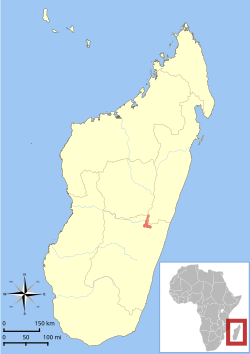| Betsileo woolly lemur | |
|---|---|
| Scientific classification | |
| Kingdom: | Animalia |
| Phylum: | Chordata |
| Class: | Mammalia |
| Order: | Primates |
| Suborder: | Strepsirrhini |
| Family: | Indriidae |
| Genus: | Avahi |
| Species: | A. betsileo |
| Binomial name | |
| Avahi betsileo Andriantompohavana et al., 2007 [3] | |
 | |
| Distribution of A. betsileo [1] | |
The Betsileo woolly lemur or Betsileo avahi (Avahi betsileo) is a species of woolly lemur native to southeastern Madagascar, in the District of Fandriana. [3] The pelage differs significantly from other southeastern woolly lemurs in that it is primarily light reddish brown on most of the body and grey under the jaw and on the extremities. [3] The pelage is thicker on the head than other eastern woolly lemurs. [3]
Contents
This lemur is an arboreal, herbivorous, nocturnal, female dominant nonhuman primate, [4] with a body length of about 48–58.9 cm (18.9–23.2 in), including a 28.3-34.4 cm (11.14-13.54 in) tail, it is weighing about 1 kg (2.2 lb). [3] Avahi betsileo prefers to inhabit humid rainforests, are vertical clingers and leapers. [5]
